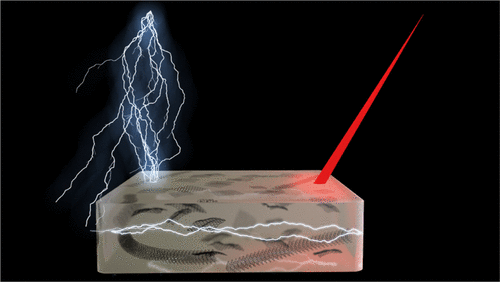当前位置:
X-MOL 学术
›
ACS Appl. Polym. Mater.
›
论文详情
Our official English website, www.x-mol.net, welcomes your feedback! (Note: you will need to create a separate account there.)
Multifunctional Biocomposites Based on Polyhydroxyalkanoate and Graphene/Carbon Nanofiber Hybrids for Electrical and Thermal Applications
ACS Applied Polymer Materials ( IF 5 ) Pub Date : 2020-07-08 , DOI: 10.1021/acsapm.0c00539 Pietro Cataldi 1 , Pietro Steiner 1 , Thomas Raine 1 , Kailing Lin 1 , Coskun Kocabas 1 , Robert J. Young 1 , Mark Bissett 1 , Ian A. Kinloch 1 , Dimitrios G. Papageorgiou 2
ACS Applied Polymer Materials ( IF 5 ) Pub Date : 2020-07-08 , DOI: 10.1021/acsapm.0c00539 Pietro Cataldi 1 , Pietro Steiner 1 , Thomas Raine 1 , Kailing Lin 1 , Coskun Kocabas 1 , Robert J. Young 1 , Mark Bissett 1 , Ian A. Kinloch 1 , Dimitrios G. Papageorgiou 2
Affiliation

|
Biobased and/or biodegradable plastics have been proposed as a sustainable alternative to long-lasting and fossil fuel-derived ones. Among those available, polyhydroxyalkanoate (PHA) shows great potential across a large variety of applications, but it is not used extensively because of its relatively poor physical properties. An expansion of its uses can be accomplished by developing nanocomposites where PHAs are utilized as the polymer matrix. Herein, a PHA biopolyester was melt-blended with graphene nanoplatelets (GNPs) or with a hybrid mixture of GNPs and carbon nanofibers. The resulting nanocomposites exhibited enhanced thermal stability and satisfactory mechanical properties. The hybrid nanocomposites percolated electrically at lower nanofiller loadings compared to the GNP–PHA system. The electrical conductivity at 15 wt % loading was ∼6 times higher than that of the GNP-based nanocomposite. As a result, the electromagnetic interference shielding performance of the hybrid material was around 50% better than the pure GNP-reinforced nanocomposites. The thermal conductivity increased significantly for both types of bionanocomposites and reached values in the order of 5 W K–1 m–1, with the hybrid-based material displaying once again the best performance. Considering the solvent-free and industrially compatible production method utilized to manufacture these nanocomposites, the proposed multifunctional materials can expand the range of applications of PHAs and increase the environmental sustainability of the plastic and plastic electronics industry.
中文翻译:

基于聚羟基链烷酸酯和石墨烯/碳纳米纤维杂化物的多功能生物复合材料,用于电气和热学领域
已经提出了基于生物的和/或可生物降解的塑料作为持久的和持久的源自化石燃料的塑料的替代物。在可用的那些中,聚羟基链烷酸酯(PHA)在各种各样的应用中显示出巨大的潜力,但由于其相对较差的物理性能而未被广泛使用。通过开发将PHA用作聚合物基质的纳米复合材料,可以扩大其用途。本文中,将PHA生物聚酯与石墨烯纳米片(GNP)或GNP和碳纳米纤维的混合混合物熔融共混。所得纳米复合材料表现出增强的热稳定性和令人满意的机械性能。与GNP–PHA系统相比,杂化纳米复合材料在较低的纳米填料负载下电渗透。负载为15 wt%时的电导率是基于GNP的纳米复合材料的电导率的约6倍。结果,杂化材料的电磁干扰屏蔽性能比纯GNP增强纳米复合材料好约50%。两种类型的生物纳米复合材料的热导率均显着提高,达到约5 WK的值–1 m –1,基于混合材料的材料再次显示出最佳性能。考虑到用于制造这些纳米复合材料的无溶剂且工业相容的生产方法,所提出的多功能材料可以扩展PHAs的应用范围,并提高塑料和塑料电子工业的环境可持续性。
更新日期:2020-08-14
中文翻译:

基于聚羟基链烷酸酯和石墨烯/碳纳米纤维杂化物的多功能生物复合材料,用于电气和热学领域
已经提出了基于生物的和/或可生物降解的塑料作为持久的和持久的源自化石燃料的塑料的替代物。在可用的那些中,聚羟基链烷酸酯(PHA)在各种各样的应用中显示出巨大的潜力,但由于其相对较差的物理性能而未被广泛使用。通过开发将PHA用作聚合物基质的纳米复合材料,可以扩大其用途。本文中,将PHA生物聚酯与石墨烯纳米片(GNP)或GNP和碳纳米纤维的混合混合物熔融共混。所得纳米复合材料表现出增强的热稳定性和令人满意的机械性能。与GNP–PHA系统相比,杂化纳米复合材料在较低的纳米填料负载下电渗透。负载为15 wt%时的电导率是基于GNP的纳米复合材料的电导率的约6倍。结果,杂化材料的电磁干扰屏蔽性能比纯GNP增强纳米复合材料好约50%。两种类型的生物纳米复合材料的热导率均显着提高,达到约5 WK的值–1 m –1,基于混合材料的材料再次显示出最佳性能。考虑到用于制造这些纳米复合材料的无溶剂且工业相容的生产方法,所提出的多功能材料可以扩展PHAs的应用范围,并提高塑料和塑料电子工业的环境可持续性。



























 京公网安备 11010802027423号
京公网安备 11010802027423号